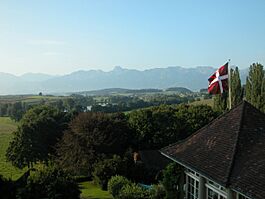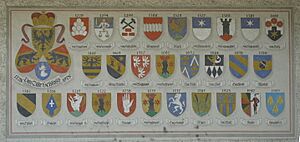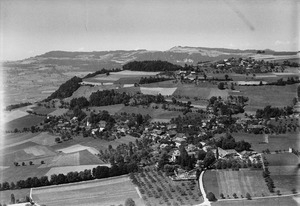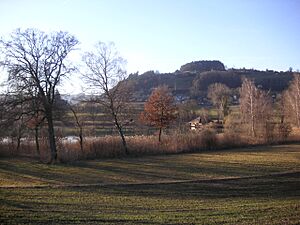Gerzensee facts for kids
Quick facts for kids
Gerzensee
|
|
|---|---|
 |
|
| Country | Switzerland |
| Canton | Bern |
| District | Bern-Mittelland |
| Area | |
| • Total | 7.81 km2 (3.02 sq mi) |
| Elevation | 646 m (2,119 ft) |
| Population
(Dec 2020 )
|
|
| • Total | 1,237 |
| • Density | 158.39/km2 (410.2/sq mi) |
| Postal code |
3115
|
| Surrounded by | Belp, Belpberg, Gelterfingen, Kirchdorf, Mühledorf, Münsingen, Wichtrach |
Gerzensee is a small town, called a municipality, in Switzerland. It is located in the Bern-Mittelland administrative district, which is part of the canton of Bern. The town gets its name from the beautiful Gerzensee lake nearby.
Contents
History of Gerzensee
Gerzensee was first mentioned in official records in the year 1228. Back then, it was known as Gercentse.
Early Settlements
The very first signs of people living in this area come from the Neolithic period, also known as the New Stone Age. Scientists have found old tools and objects scattered around. Later, during the La Tène period (around 450 BC to 50 BC) and the Roman era, people continued to live here.
Castles and Land Ownership
During the Middle Ages, a powerful noble, the Freiherr von Kramburg, built a castle called Festi Castle (also known as the Old Castle) above the village. He controlled a part of the valley from there. After the 1300s, other nobles bought the Kramburg lands. Over many centuries, the land was bought and sold several times. By the late 1600s, Gerzensee was split in half and sold to two different noble families.
The Old Castle was damaged by a fire in 1518. Jakob von Wattenwyl had it rebuilt in a late-Gothic style. This style is known for its pointed arches and tall windows. The Old Castle changed hands many times until the Stuker family bought it in 1947.
The New Castle
In 1700, Samuel Morlot decided to build a large country house, which became known as the New Castle. This was on a part of the estate he owned. In 1755, Franz Emanuel Anton von Graffenried bought all the different pieces of the estate. He brought the manor house, village, lake, and farmland back together as one large property.
However, in 1798, the French invaded Switzerland. This led to the creation of the Helvetic Republic. This new government took away the old powers that wealthy landowners had. In 1813, the von Graffenried family sold the New Castle and the lake to the von Erlach family. They later sold it in 1918. In 1980, the Swiss National Bank bought the New Castle. They turned it into a special research center.
Village Church and Growth
The village church was likely built during the High Middle Ages. It was first mentioned in 1228 as St. Mary's Church. The church was rebuilt in the late 1400s and then updated again in the 1500s and 1600s. In 1479, the villagers built a small chapel. But it was taken down around 1528 when Bern adopted the Protestant Reformation. This was a big change in Christian beliefs.
From the 1600s to the 1800s, the sunny southern side of the Belpberg mountain became popular. Wealthy families from Bern built country homes there. In 1633, a special mineral water spa opened in the village. This was a place where people could bathe in water believed to have healing properties. The old baths were completely changed in 1906. As the city of Bern grew, Gerzensee became a commuter town. This means many people live in Gerzensee but travel to Bern for work. Many new homes were built in the 1970s. Today, about half of the people who work in Gerzensee travel to Bern for their jobs.
Geography of Gerzensee
Gerzensee covers an area of about 7.8 square kilometers (3 square miles). A large part of this area, about 67.8%, is used for farming. Forests cover about 20.3% of the land. Buildings and roads make up about 9.0% of the area. Rivers and lakes cover about 3.6%.
Most of the settled area is made up of houses and other buildings (6.3%). Roads and other transport areas make up 2.1%. A lot of the forested land (18.6%) is dense forest. About 1.7% has orchards or small groups of trees. For farming, 39.3% is used for crops, and 25.7% is for pastures where animals graze.
The municipality stretches from the southeast side of the Belpberg mountain to the Aare river. The main village of Gerzensee sits on a raised area above the Gerzensee Lake. The municipality also includes smaller groups of homes called Sädel, Vorderchlapf, and Hinterchlapf.
Future Changes
The towns of Gelterfingen, Gerzensee, Kirchdorf, Mühledorf, and Noflen are thinking about joining together. If they do, they would form a new, larger municipality. This change might happen on January 1, 2017.
In 2010, Gerzensee became part of a new administrative area called Verwaltungskreis Bern-Mittelland.
Gerzensee Coat of Arms
The blazon (official description) of Gerzensee's coat of arms is: "Azure an Angel volant proper robed and winged Argent holding in his dexter hand Scales Or and in his sinister a Palm Branch vert." This means it shows a blue background with a flying angel. The angel is dressed in silver and has silver wings. In one hand, the angel holds golden scales, and in the other, a green palm branch.
Population and People
Gerzensee has a population of about 1,140 people (as of December 2011). In 2011, about 5.3% of the people living in Gerzensee were from other countries. The population grew by about 2.9% between 2010 and 2011. Most of this growth was from people moving into the town.
Languages Spoken
Most people in Gerzensee (about 97.0%) speak German as their main language. French is the second most common language, spoken by about 1.5% of the population. A small number of people also speak Portuguese.
Where People Come From
In 2000, about 33.9% of the people living in Gerzensee were born there. About 45.6% were born in the same canton (Bern). Another 11.9% were born elsewhere in Switzerland, and 5.5% were born outside of Switzerland.
Age Groups
As of 2011, children and teenagers (0–19 years old) make up about 22.5% of the population. Adults (20–64 years old) make up 61.1%, and seniors (over 64 years old) make up 16.4%.
Housing
In 2010, there were 123 homes where only one person lived. There were also 35 homes with five or more people. In 2011, single-family homes made up about 51.9% of all the housing in Gerzensee.
The chart below shows how the population of Gerzensee has changed over time:

Important Heritage Sites
The old farm house at Rütimatt, which belonged to a noble family, is a very important historical building. It is listed as a heritage site of national significance in Switzerland. The entire village of Gerzensee, along with a small group of homes called Vordere Chlapf, are also part of the Inventory of Swiss Heritage Sites. This means they are protected because of their historical and cultural value.
Economy and Jobs
In 2011, Gerzensee had a low unemployment rate of 2.14%. This means most people who wanted jobs had them. In 2008, there were 302 people working in the municipality.
Types of Jobs
- Primary Sector: About 98 people worked in the primary sector. This includes jobs like farming and forestry. There were about 35 businesses in this area.
- Secondary Sector: About 59 people worked in the secondary sector. This includes jobs like manufacturing (making things) and construction (building things). There were 10 businesses in this sector.
- Tertiary Sector: About 145 people worked in the tertiary sector. This includes jobs in services, like shops, restaurants, and education. There were 25 businesses in this sector.
In 2008, there were 230 full-time equivalent jobs. This means if you add up all the part-time jobs, it would be like 230 full-time jobs. Most of the jobs in the primary sector were in agriculture. In the secondary sector, jobs included manufacturing and construction. In the tertiary sector, jobs were in sales, transport, hotels, restaurants, education, and healthcare.
Commuting
In 2000, 132 workers traveled into Gerzensee for their jobs. However, 302 workers traveled out of Gerzensee to work in other places. This shows that more people leave Gerzensee for work than come in. About 59% of the workers in Gerzensee also lived there. Many people (50.8%) used a private car to get to work, while 15.7% used public transportation.
Religion
Based on the 2000 census, most people in Gerzensee (75.7%) belonged to the Swiss Reformed Church. About 8.5% were Roman Catholic. A smaller number of people belonged to other Christian churches, or were Muslim or Hindu. About 7.79% of the population did not belong to any church.
Education
In Gerzensee, about 55.2% of adults have finished non-mandatory upper secondary education. This is like high school. About 23.4% have gone on to higher education, like a university or a specialized college.
School System
The Canton of Bern has a specific school system. It starts with one year of non-required Kindergarten. After that, students go to six years of Primary school. Then, they have three years of lower Secondary school. In secondary school, students are grouped based on their abilities. After lower secondary, students can choose to continue their education or start an apprenticeship (learning a trade on the job).
During the 2011-12 school year, 107 students attended classes in Gerzensee. There was one kindergarten class with 19 students. The municipality had three primary classes with 60 students. There were also two lower secondary classes with 28 students.
In 2000, 118 students attended school in Gerzensee. Most of them (83) lived and went to school in the municipality. However, 35 students came from other towns. Also, 42 residents of Gerzensee went to schools outside the municipality.
|
See also
 In Spanish: Gerzensee para niños
In Spanish: Gerzensee para niños









